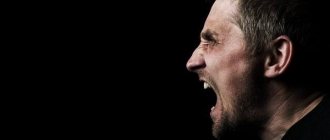A person is, first of all, a social being: he cannot build his life without interacting with other members of society, therefore, he is subject to generally accepted rules and norms established in a certain social group. Following the behavioral norms characteristic of the society in which a person lives is the basis of his socialization.
The skills necessary for active and full interaction with society are not innate: a person acquires them in the process of development. In some situations, a person consciously or unconsciously refuses to comply with established rules: in this case, psychologists talk about deviance or delinquency of his behavior. Both delinquent and deviant behavior are considered deviations from behavioral norms.
Definition of deviant and delinquent behavior
Psychologists distinguish two types of non-standard social actions: deviance and delinquency. People who are far from psychology often consider these concepts to be identical, which is not entirely true.
Deviant behavior is a relative concept, implying non-compliance with certain social norms. This concept is considered relative for the reason that certain actions can have an ambiguous interpretation in different social groups: what is considered normal for some people is a disgusting and inadequate act for others.
Informal rules in this case include:
- national traditions and local customs;
- good manners and etiquette;
- norms of behavior in any closed society.
The term "delinquent behavior" comes from the Latin noun delictum, used to mean "misdemeanor." Typically, this term refers to antisocial and illegal behavior that violates public order and threatens the rights and freedoms of other citizens. This concept is used not only by psychologists, but also by criminologists, lawyers, sociologists, and teachers.
Similarities and differences between the terms “deviance” and “delinquency”
Common features of deviance and delinquency:
- both terms imply deviation from generally accepted social norms. At the same time, people’s actions are compared both with legally established state norms and with informal behavioral guidelines;
- Both deviation and delinquency imply a person’s lack of desire to find his place in society, meet its requirements and comply with generally accepted rules.
If we talk about the differences between these terms, they are as follows:
- Delinquent behavior is human behavior that includes completely illegal actions. Vivid examples of delinquent behavior can be robbery, murder, any violent acts, fraud, and bullying. Delinquency includes primarily those deviations that carry legal consequences;
- Deviance is a broader concept that includes generally accepted deviations from socially approved norms.
In a narrow sense, deviant behavior may include offenses that do not entail criminal liability, and delinquent behavior may include administrative fines and criminal punishment.
Delinquent behavior is not yet criminal
An adult who takes someone else's property, gets into a group fight with a weapon, or seriously threatens another will most likely face criminal penalties. Experts will consider such behavior criminal. The behavior of a teenager who commits minor illegal acts or, due to age, is not yet subject to the criminal code, is called delinquent (from the English delinquency
- offense, delinquency).
According to statistics from the Ministry of Internal Affairs, in 2022, every 27th crime in Russia was committed by minors or with their complicity. This is much less than in the early 2000s, when teenagers were involved in every 10th criminal act.
Causes of delinquent behavior
Speaking about the prerequisites for deviation from behavioral norms, it is impossible to single out any single reason as a result of which a person’s behavior suddenly becomes asocial. Usually, there are many prerequisites for such behavior, which include both the psycho-emotional state of a person and the external factors affecting him.
Psychophysiological factors in the occurrence of delinquent behavior include personality type and character, the presence of various addictions (alcohol, drugs, gaming and others), mental illness, and level of anxiety.
If we talk about external factors influencing the human psyche, then we can highlight the family reasons for the progression of delinquency and the socio-economic prerequisites for the occurrence of such a condition.
Family factors include:
- parental divorce;
- death of a close relative with whom the person had a particularly warm relationship;
- alcoholism or drug addiction in one of the family members;
- unfavorable environment in the house: constant quarrels, swearing and fights;
- excessive guardianship on the part of parents, the desire to control every step of the child;
- physical and moral violence in the family.
Social factors include:
- social and material inequality between people;
- conflicts based on national intolerance;
- loss of work, lack of livelihood;
- change of social environment.
INTRODUCTION
The history of the development of clinical psychology is a winding path. Situated on the border between medicine and psychology, the new science continually nailed itself to one side or the other of the river called “human science.” To be fair, it should be noted that to date the location of clinical psychology has not been fully defined, which can be explained by the interdisciplinary nature of this science.
The starting point for the emergence of clinical psychology can be considered the call of doctors to “treat not the disease, but the patient.” It was from that time that the interpenetration of psychology and medicine began. Initially, clinical psychology, which was actively developed by psychiatrists, was aimed at studying deviations in intellectual and personal development, correcting maladaptive and delinquent forms of behavior. However, subsequently the scope of interests of clinical psychology was expanded to include the study of the mental state of persons with somatic diseases.
The term "clinical psychology" comes from the Greek kline, which means bed, hospital bed. In modern psychology, as a rule, the terms “clinical” and “medical” psychology are used as synonyms. Given this fact, in the further presentation we will use only one of them. However, let us take into account the existing tradition of doctors to designate this area of knowledge as “medical psychology”, and psychologists as “clinical psychology”.
Clinical (medical) psychology
- a science that studies the psychological characteristics of people suffering from various diseases, methods and methods for diagnosing mental disorders, differentiating psychological phenomena and psychopathological symptoms and syndromes, the psychology of the relationship between the patient and the medical worker, psychoprophylactic, psycho-corrective and psychotherapeutic methods of helping patients, as well as theoretical aspects psychosomatic and somato-psychic mutual influences.
Today there are quite a large number of related psychological disciplines related to clinical psychology: pathopsychology, psychopathology, neuropsychology, psychology of deviant behavior, psychiatry, neurosology, psychosomatic medicine, etc. Each of these disciplines combines medical and psychological knowledge. However, they are all relevant to the clinic and, as a result, can be recognized as components of clinical psychology. In accordance with traditions, clinical psychology includes the following sections:
- patient psychology
- psychology of therapeutic interaction
- norm and pathology of mental activity
- pathopsychology
- psychology of individual differences
- developmental clinical psychology
- family clinical psychology
- psychology of deviant behavior
- psychological counseling, psychocorrection and psychotherapy
- neurosology
- psychosomatic medicine
Clinical psychology is closely related to related disciplines, primarily psychiatry and pathopsychology. The area of general scientific and practical interest of clinical psychology and psychiatry is the diagnostic process. Recognition of psychopathological symptoms and syndromes is impossible without knowledge of their psychological antonyms - phenomena of everyday life that reflect the individual psychological characteristics of a person and are located within the normal variations of mental response. In addition, the process of diagnosing mental illness cannot do without “pathopsychological verification.”
Clinical psychology borrows methods for studying the mental characteristics of somatically ill people from psychodiagnostics and general psychology; assessment of the adequacy or deviance of human behavior in psychiatry, developmental psychology and developmental psychology. The study of clinical psychology is impossible without medical knowledge, in particular from the field of neurology, neurosurgery and related disciplines. The psychosomatic section of clinical psychology is based on scientific ideas from such areas as psychotherapy, vegetology, valeology.
The most complete list of theoretical knowledge and practical skills of a clinical (medical) psychologist can be gleaned from the qualification characteristics of a specialist in this field. In accordance with the order of the Ministry of Health of the Russian Federation No. 391 dated November 26, 1996, a medical psychologist is required to have the following
Theoretical knowledge:
Psychology and its significance for medicine: subject, tasks and interdisciplinary connections of medical psychology, history of the formation of medical psychology as a field of psychological science; medical psychology as a profession; main branches of medical psychology.
The main theoretical and methodological problems of medical psychology: brain and psyche, psychosomatic and somatopsychic relationships. The relationship between the biological and the social, the problem of norm and pathology, genetic and acquired, hereditary and personal-environmental, development and disintegration of the psyche, organic and functional, conscious and unconscious, adaptation and maladaptation, deficient and adaptive.
A systematic approach as a theoretical basis for understanding the psychological structure of the disease, restorative treatment and rehabilitation of patients.
Basic (fundamental) medical concepts: etiology, pathogenesis and sanogenesis, symptom, syndrome, clinical diagnosis, functional (multidimensional or multiaxial) diagnosis.
Related knowledge: basics of general and private psychiatry, basics of neurology, the doctrine of borderline mental disorders, self-destructive behavior, basics of psychophysiology and psychopharmacology.
Psychological (psychogenic) factors in the etiology, pathogenesis and pathoplasty of mental and psychosomatic disorders, the concept of pre-illness, mental adaptation disorders, social stress disorders, crisis conditions.
Classification of methods of medical psychology, psychological diagnostics as a tool for targeted study of personality, methods of psychological diagnostics in the clinic, computer psychodiagnostics, psychological correction.
The concept of psychological diagnosis, functional diagnosis as a result of the integration of clinical, psychological and social aspects of the disease, the concept of psychological contact.
Main categories of medical psychology: mental activity, perception, attention, memory, thinking, intelligence, emotions, will, temperament, character, personality, motivation, needs
anxiety, stress, frustration, consciousness and self-awareness, self-esteem, conflict, crisis, psychogenesis, psychological defense, coping, alexithymia.
Experimental theory, concepts of standardized and non-standardized methods, theory and classification of tests, basic psychometric concepts (validity, reliability, standardization, norm, etc.).
Fundamentals of clinical neuropsychology: systemic mechanisms of the brain in the organization of higher mental functions, processes and states, functional specialization of the hemispheres - basic concepts and practice, correlations between the cerebral and local in neuropsychology, nosological specificity of disorders of higher mental functions, specificity of neuropsychological research in childhood; main neuropsychological syndromes and methods of their diagnosis.
The concept of pathopsychology: the relationship between qualitative and quantitative approaches in the analysis of psychodiagnostic data, pathopsychological phenomenology, patterns and structural features of disorders of cognitive processes, properties and conditions caused by the disease, nosological and syndromological specificity of pathopsychological phenomenology, differential diagnostic and expert significance of the pathopsychological experiment, pathopsychological studies in assessing the dynamics of treatment.
Age-related aspects of psychological disorders: age-related characteristics of psychological disorders in various diseases, mental development of an abnormal child, childhood autism, the problem of dysontogenesis and mental retardation, psychological abnormalities of adolescence, characteristics of childhood and adolescent forms of pathological reaction, psychological aspects of mental infantilism, psychological problems of geriatrics and gerontology.
The doctrine of character: the concept of accentuation and psychopathy, classification of character accentuations, diagnostic methods.
The doctrine of personality: basic concepts of personality in domestic and foreign psychology, diagnostic methods, the concept of protective mechanisms of personality, personality and illness.
Basic concepts of psychosomatic relationships. Psychosomatic and somatopsychic. The internal picture of the disease and attitude towards the disease, methodology and research methods, nosological specificity of psychological phenomena and the internal picture of the disease. Theoretical and methodological aspects, methods of psychological diagnostics in various types of examination.
Theoretical, methodological and methodological approaches to solving problems of psychoprophylaxis and mental hygiene, the concepts of mass research, psychological screening, risk factors, mental maladaptation and illness.
Rehabilitation approach in medicine: concept, concepts, basic principles, forms and methods.
Psychology of extreme and crisis conditions, the concept of traumatic stress, social frustration and social stress disorders.
Basic principles of psychological support of the treatment process: organization of the psychotherapeutic environment in treatment units. Relationships between doctor and patient, psychologist and doctor and treatment room, etc.
Psychological aspects of drug and non-drug therapy, placebo effect, psychological problems of preparing patients for surgery, prosthetics, psychological problems of chronically ill, disabled and dying people.
Medical and psychological aspects of social behavior: communication, role behavior, interaction in groups, social normativity, etc.
Features of the work of medical psychologists in inpatient, outpatient and preventive institutions of various types, psychological counseling, vocational selection, career guidance.
Psychological foundations of psychotherapy, restorative training and rehabilitation.
Basic psychotherapeutic theories: psychodynamic, behavioral, existential-humanistic; person-oriented psychotherapy; medical and psychological models of psychotherapy; main forms of psychotherapy: individual group, family, environmental therapy, psychotherapeutic community, sociotherapy; mechanisms of therapeutic action of psychotherapy; nosological specificity and age-related aspects of psychotherapy and psychological counseling; psychological problems of non-verbal methods of psychotherapy: music therapy, choreotherapy, art therapy, etc.
Psychotherapy and psychological counseling in crisis situations.
Legal aspects of the activities of medical psychologists.
Deontological aspects of the behavior of a medical psychologist.
Practical skills:
The practical skills and abilities of a medical psychologist must provide a qualified professional solution to problems in the field of psychodiagnostics (including expert), psychocorrection and psychological counseling.
In the field of psychodiagnostics:
- the ability to conduct a psychological examination taking into account nosological and age specifics, as well as in connection with the tasks of medical and psychological examination; creating the necessary psychological contact and adequate ongoing control of psychological distance; planning and organizing research; selection of an adequate methodological apparatus; ability to carry out quantitative and qualitative analysis of research results in connection with various purposes: differential diagnosis, analysis of the severity of the condition, assessment of the effectiveness of therapy, etc., mastery of basic interpretive schemes and approaches, adequate presentation of available data in a psychodiagnostic report, mastery of basic clinical and psychological methods (psychological conversation, collection of psychological history, psychological analysis of biography, natural experiment);
- mastery of basic experimental psychological techniques aimed at studying mental functions, processes and states: perception, attention, memory, thinking, intelligence, emotional-volitional sphere, temperament, character, personality, motivational characteristics and needs, self-awareness and interpersonal relationships.
- mastery of basic techniques of neuropsychological research (methods for assessing the state of gnosis, praxis, speech functions, etc.);
- knowledge of the basics of computer diagnostics.
In the field of psychological counseling and the use of psychocorrectional methods:
- the use of basic methods of psychological correction (individual, family, group) in working with patients and psychological counseling, taking into account nosological and age specifics;
- knowledge of methods of individual, group and family counseling of healthy people, taking into account age specifics in connection with the tasks of psychoprophylaxis;
- mastery of basic techniques of rehabilitation training;
- knowledge of approaches to organizing a psychotherapeutic environment and a psychotherapeutic community;
- possession of skills in conducting personal and professionally oriented trainings.
Picture 1.
DOCTOR
NURSE
PATIENT
SOCIAL WORKER
CLINICAL PSYCHOLOGIST
A clinical (medical) psychologist, along with a doctor, nurse and social worker, form the closest circle providing medical and psychological assistance to the patient (Figure 1). At the same time, the role of a clinical psychologist is significant both in diagnostic and in psychocorrectional and psychotherapeutic terms.
The practical guide is intended for doctors (psychiatrists, psychotherapists, neurologists and representatives of other disciplines), medical and practicing psychologists, nurses and social workers, and for students studying clinical (medical) psychology.
Types of delinquent behavior
Addiction . By this term, psychologists primarily mean harmful addictions. These include alcoholism, drug addiction, various forms of sexual and food addiction, and gambling addiction. One of the forms of addiction is a person’s belonging to a sect. In cases of addiction, there is a voluntary distancing of a person from society, a desire to live in a world of distorted reality.
Disciplinary violations . Disciplinary offenses include deliberate violation of the approved routine, failure to fulfill work and social duties, systematic tardiness, and disregard for safety precautions.
Administrative offenses . This category includes violations of public order that entail administrative liability. These include drinking alcohol in public places, using obscene language, and violating traffic rules.
Crimes . All acts for which penalties are provided for by the Criminal Code of the state in which the person is located fall under the category of crimes. A crime is considered to be a particularly serious offense that entails serious consequences.
Features of delinquent behavior in adolescents
The concept of delinquent behavior is especially often considered in the context of studying behavioral disorders in children and adolescents. Nowadays, this problem does not lose its relevance, as psychologists and law enforcement officials note an increase in the number of serious crimes committed by minors.
Features of delinquent behavior in adolescents:
- often illegal actions are committed by a group of teenagers, since participation in some community gives a feeling of anonymity and impunity;
- delinquent behavior often begins with a denial of adult authority;
- at a young age a person shows the strongest tendency to addiction;
- The commission of offenses is facilitated by the mental instability of young people, excessive excitability and the desire to take risks.
Various forms of delinquent behavior in adolescents can be caused by selfish and violent motives. Selfish actions are committed by a teenager to obtain momentary benefits, and often the young person himself cannot explain the motives for his actions. Violent actions give a teenager an imaginary opportunity to assert himself, stand out in any social group, and emphasize his importance.
Chapter 1. RESEARCH METHODS IN CLINICAL PSYCHOLOGY
The choice of research methods used by a clinical psychologist is determined by the tasks that arise before him in the performance of his professional duties. The diagnostic function dictates the use of psychological techniques (batteries of tests, questionnaires, etc.) capable of assessing both the activity of individual mental functions, individual psychological characteristics, and differentiating psychological phenomena and psychopathological symptoms and syndromes. The psychocorrectional function involves the use of various scales, on the basis of which it is possible to analyze the effectiveness of psychocorrectional and psychotherapeutic techniques. The selection of the necessary techniques is carried out depending on the goals of the psychological examination; individual characteristics of the mental and somatic state of the subject; his age; profession and level of education; time and place of the study. All possible research methods in clinical psychology can be divided into three groups: 1) clinical interviewing, 2) experimental psychological research methods, 3) assessing the effectiveness of psychocorrectional influences. Let's look at them in more detail.
Examples of delinquent behavior
The most striking examples of delinquent behavior:
- animal abuse;
- domestic violence;
- prostitution;
- vandalism;
- deliberate destabilization of the situation in society in times of crisis;
- creating fake news;
- alcoholism, drug addiction and their consequences;
- begging;
- participation in terrorist groups;
- creation and distribution of pornographic materials;
- inclination to suicidal actions;
- other administrative and criminal offenses.
One of the most important causes of delinquency is a person’s distorted moral consciousness. The tendency to such manifestations is formed at a very young age, so prevention of behavioral deviations must be carried out from the early years of a child’s life.
Regulation and correction of the behavior of people prone to delinquency occurs through the establishment of legislative norms. People who do not comply with traditional behavioral norms are subject to social condemnation, which can also be effective in the early stages of delinquency.










